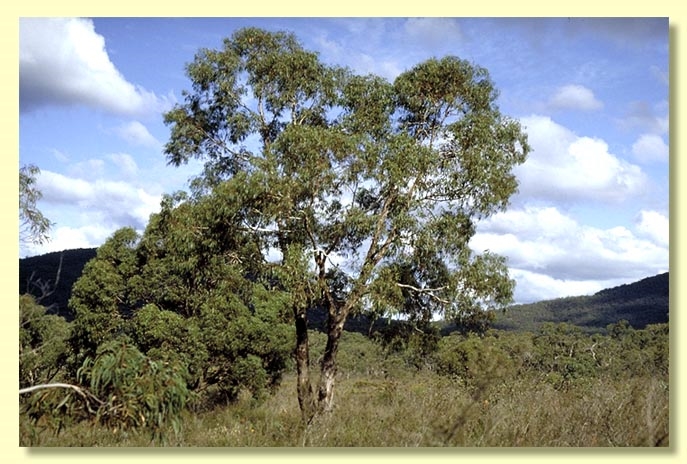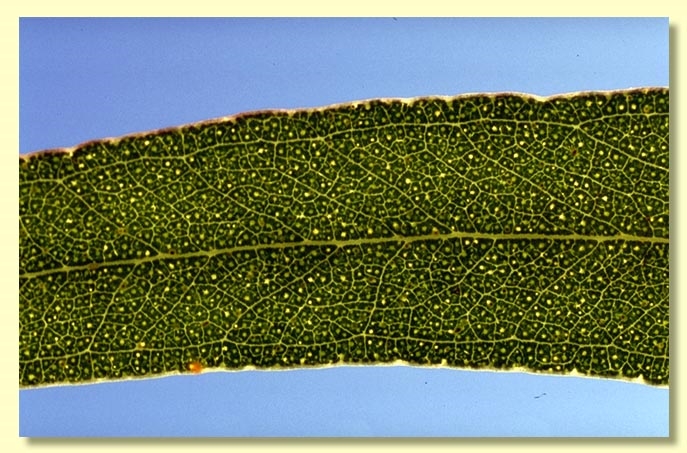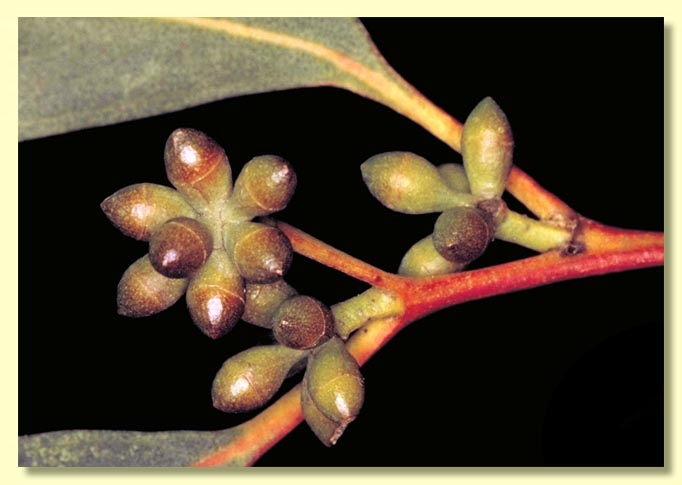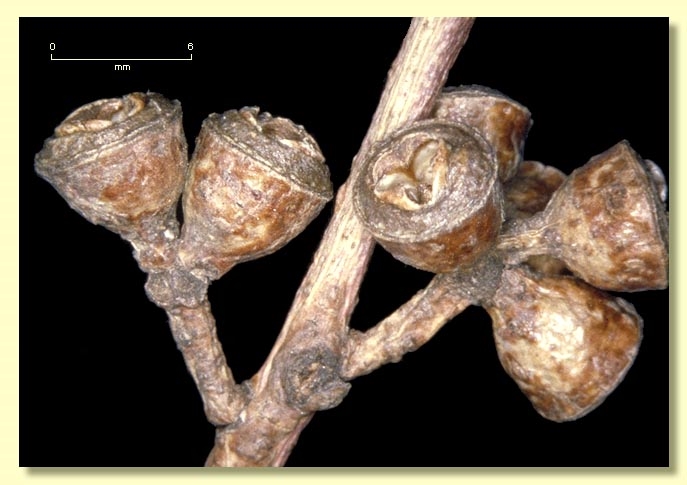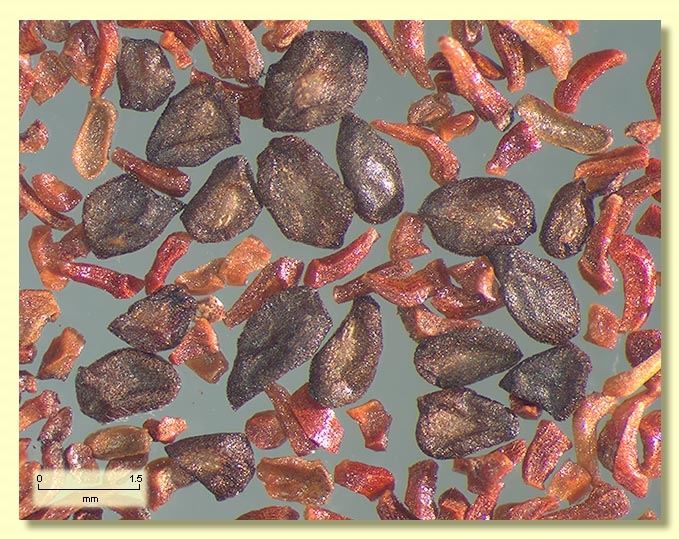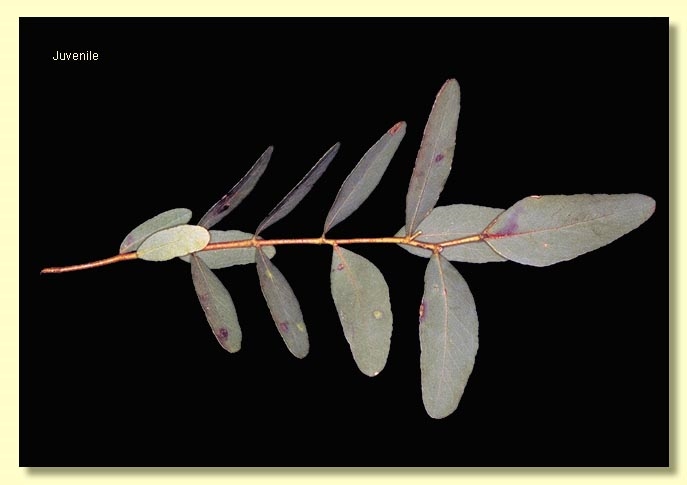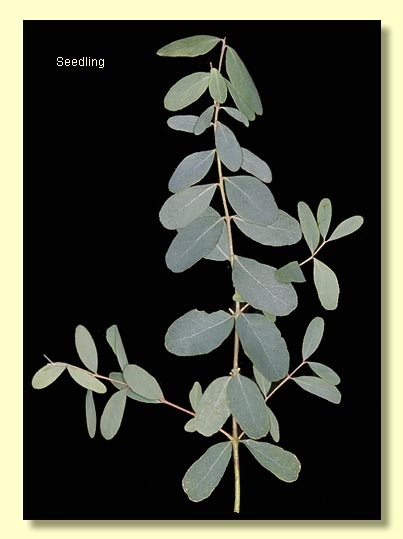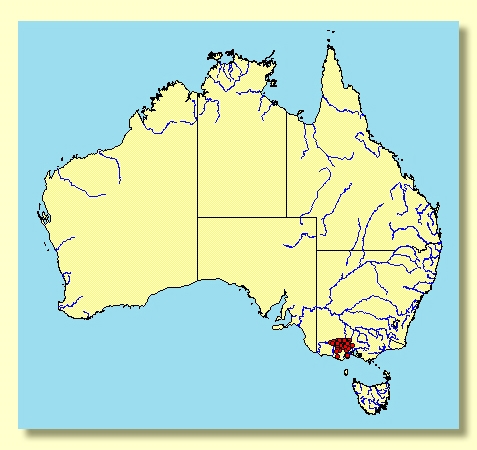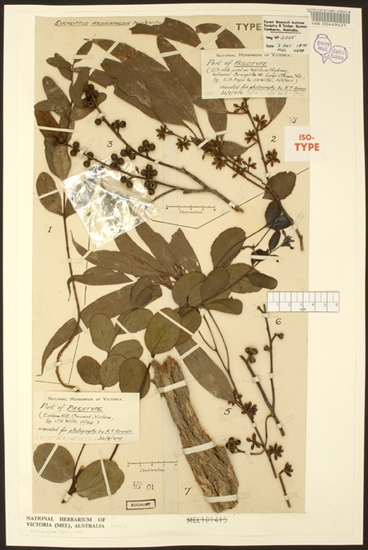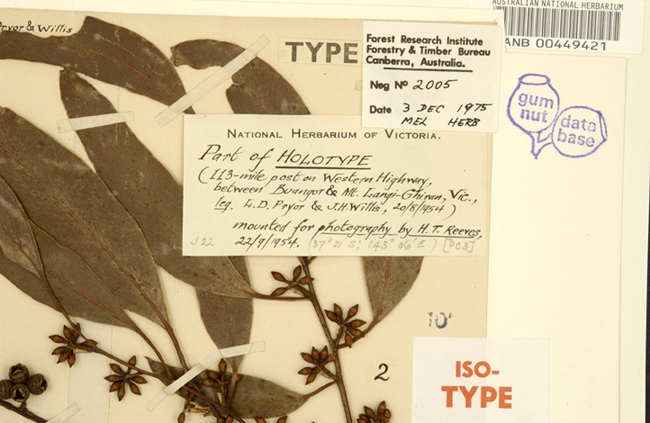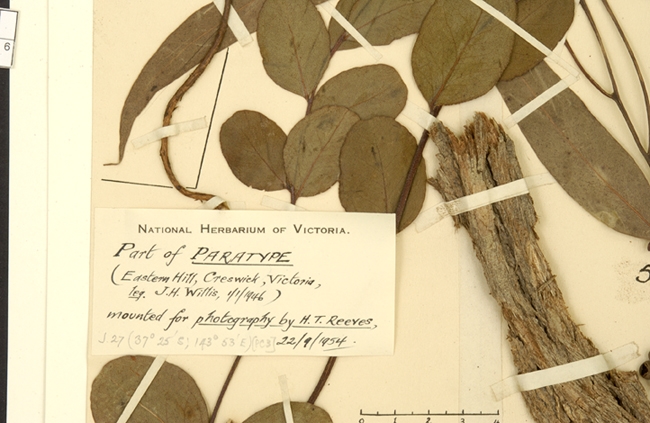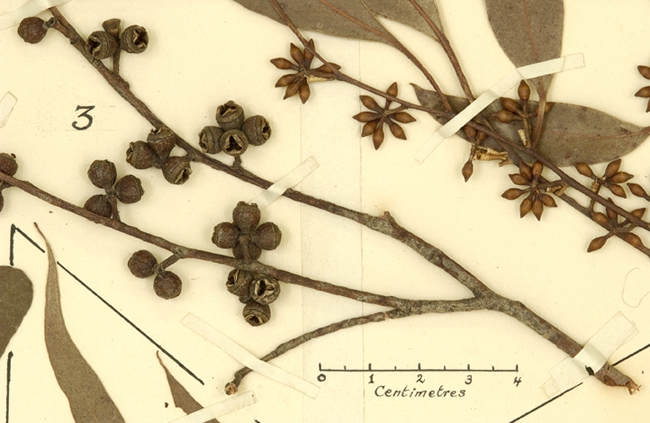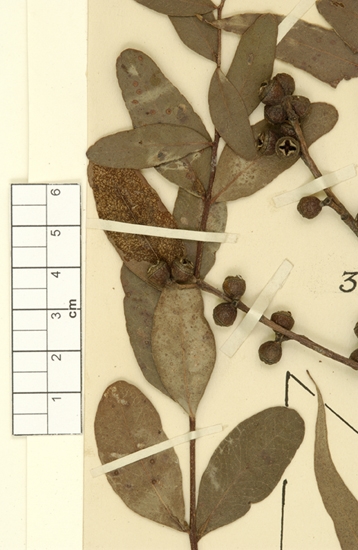Euclid - Online edition
Eucalyptus aromaphloia subsp. aromaphloia
Classification
Eucalyptus | Symphyomyrtus | Maidenaria | Triangulares | Acaciiformes
Nomenclature
Description
Tree to 18 m tall. Forming a lignotuber.
Bark rough to small branches, thick, furrowed longitudinally, dark grey to blackish, densely fibrous, sometimes with horizontal black scars, smooth branchlets salmon-coloured.
Juvenile growth (coppice or field seedlings to 50 cm): stem rounded in cross-section, slightly warty or smooth; juvenile leaves usually shortly petiolate, opposite for several pairs then becoming alternate, elliptical to oblong at first, eventually more ovate then falcate (the duration of juvenile phases is very variable), 3–7.8 cm long, 0.9–3.5 cm wide, margin entire or crenulate, grey-green, blue-green or green, only the new growing tips glaucous.
Adult leaves alternate, petiole 0.8–2.2 cm long; blade lanceolate to falcate, 7.5–20 cm long, 1–2 cm wide, flat (rarely undulate), base tapering to petiole, margin entire, concolorous, glossy or dull, green to grey-green, side-veins greater than 45° to midrib, moderately to densely reticulate, intramarginal vein parallel to and well removed from margin, oil glands island or intersectional.
Inflorescence axillary unbranched, peduncles 0.3–0.8 cm long, buds 7 per umbel (rarely more), pedicels to 0.3 cm long or rarely buds sessile. Mature buds ovoid to fusiform, 0.4–0.5 cm long, 0.3–0.4 cm wide, green tinged red, scar present, operculum conical, stamens inflexed or irregularly flexed, anthers cuneate to cuboid, versatile, dorsifixed, dehiscing by longitudinal slits (non-confluent), style long, locules 3 or 4, the placentae each with 4 vertical ovule rows. Flowers white.
Fruit sessile or pedicellate (pedicels to 0.4 cm long), cup-shaped, obconical or hemispherical, 0.3–0.4 cm long, 0.4–0.7 cm wide, disc raised, valves 3 or 4, strongly exserted.
Seed brown, reddish brown or grey, 1–2.5 mm long, ovoid or flattened-ovoid, often pointed at one end, dorsal surface usually lacunose, dorsal surface shallowly pitted, hilum ventral.
Cultivated seedlings (measured at ca node 10): cotyledons bilobed to oblong; stems rounded in cross-section; leaves always shortly petiolate, opposite for 9 to 16 nodes then alternate, elliptical to oblong, 3–7 cm long, 0.8–3.5 cm wide, base tapering, apex rounded, margin subcrenulate, green to bluish green. Leaves ovate by ca node 20.
Bark rough to small branches, thick, furrowed longitudinally, dark grey to blackish, densely fibrous, sometimes with horizontal black scars, smooth branchlets salmon-coloured.
Juvenile growth (coppice or field seedlings to 50 cm): stem rounded in cross-section, slightly warty or smooth; juvenile leaves usually shortly petiolate, opposite for several pairs then becoming alternate, elliptical to oblong at first, eventually more ovate then falcate (the duration of juvenile phases is very variable), 3–7.8 cm long, 0.9–3.5 cm wide, margin entire or crenulate, grey-green, blue-green or green, only the new growing tips glaucous.
Adult leaves alternate, petiole 0.8–2.2 cm long; blade lanceolate to falcate, 7.5–20 cm long, 1–2 cm wide, flat (rarely undulate), base tapering to petiole, margin entire, concolorous, glossy or dull, green to grey-green, side-veins greater than 45° to midrib, moderately to densely reticulate, intramarginal vein parallel to and well removed from margin, oil glands island or intersectional.
Inflorescence axillary unbranched, peduncles 0.3–0.8 cm long, buds 7 per umbel (rarely more), pedicels to 0.3 cm long or rarely buds sessile. Mature buds ovoid to fusiform, 0.4–0.5 cm long, 0.3–0.4 cm wide, green tinged red, scar present, operculum conical, stamens inflexed or irregularly flexed, anthers cuneate to cuboid, versatile, dorsifixed, dehiscing by longitudinal slits (non-confluent), style long, locules 3 or 4, the placentae each with 4 vertical ovule rows. Flowers white.
Fruit sessile or pedicellate (pedicels to 0.4 cm long), cup-shaped, obconical or hemispherical, 0.3–0.4 cm long, 0.4–0.7 cm wide, disc raised, valves 3 or 4, strongly exserted.
Seed brown, reddish brown or grey, 1–2.5 mm long, ovoid or flattened-ovoid, often pointed at one end, dorsal surface usually lacunose, dorsal surface shallowly pitted, hilum ventral.
Cultivated seedlings (measured at ca node 10): cotyledons bilobed to oblong; stems rounded in cross-section; leaves always shortly petiolate, opposite for 9 to 16 nodes then alternate, elliptical to oblong, 3–7 cm long, 0.8–3.5 cm wide, base tapering, apex rounded, margin subcrenulate, green to bluish green. Leaves ovate by ca node 20.
Flowering Time
Flowering has been recorded in January, February and March.
Notes
Eucalyptus aromaphloia is a small to medium-sized tree species endemic to Victoria, occurring roughly west from a line between Daylesford and Anglesea west to about Casterton.
E. aromaphloia belongs in Eucalyptus subgenus Symphyomyrtus section Maidenaria, a large group of species more or less restricted to south-eastern Australia, characterised by bilobed cotyledons, simple axillary inflorescences, buds with two opercula, stamens with versatile anthers and flattened seeds with a ventral hilum. Within this section E. aromaphloia and five other species form series Acaciiformes diagnosed by the rough bark, juvenile leaves that are soon alternate, glandular adult leaves, non-swampy habitat, and small, rather flat-topped fruit. Three of these species, E. aromaphloia, E. fulgens and E. ignorabilis are restricted to southern Victoria and far south-eastern New South Wales and can easily be confused.
E. aromaphloia is distinguished from E. fulgens, which occurs east from Melbourne to the Driffield area, by its more or less dull green to blue-green adult leaves (glossy green in E. fulgens) and elliptic to linear juvenile leaves (ovate-lanceolate in E. fulgens).The third species, E. ignorabilis, occurs in east Gippsland and far south-eastern New South Wales, and has a dull, geen-leaved crown and ovate-lanceolate juvenile leaves and more fibrous, less furrowed rough bark than either E. aromaphloia or E. fulgens.
Of the remaining three species in series Acaciiformes, E. acaciiformis and E. nicholii occur in north-eastern New South Wales and should not be confused. E. corticosa is very close to E. aromaphloia in all but distribution (see details below).
E. aromaphloia has been confused with E. viminalis subsp. cygnetensis, but the former differs by the whole trunk being rough-barked, often deeply furrowed like an ironbark, by the juvenile leaves which taper at the base to a very short petiole, never stem-clasping. Eucalyptus splendens from south-western Victoria and south-eastern South Australia differs from E. aromaphloia in having seedling and juvenile growth with square stems, not rounded, bearing leaves opposite for many nodes.
There are two subspecies:
E. aromaphloia subsp. aromaphloia
This has elliptical to oblong usually bluish green juvenile leaves and occurs from the eastern Grampians east to the Daylesford area and south to Anglesea.
E. aromaphloia subsp. sabulosa
This subspecies occurs predominantly from the central Grampians west to the Little Desert and south-west to Cavendish, but also between Vaughan and Drummond in central Victoria, and has linear, greener juvenile leaves. The two subspecies grade into each other. E. corticosa, a restricted endemic near Rylstone in central western New South Wales, is very close to subsp. sabulosa and differs only marginally by usually having smooth bark on the larger branches.
E. aromaphloia belongs in Eucalyptus subgenus Symphyomyrtus section Maidenaria, a large group of species more or less restricted to south-eastern Australia, characterised by bilobed cotyledons, simple axillary inflorescences, buds with two opercula, stamens with versatile anthers and flattened seeds with a ventral hilum. Within this section E. aromaphloia and five other species form series Acaciiformes diagnosed by the rough bark, juvenile leaves that are soon alternate, glandular adult leaves, non-swampy habitat, and small, rather flat-topped fruit. Three of these species, E. aromaphloia, E. fulgens and E. ignorabilis are restricted to southern Victoria and far south-eastern New South Wales and can easily be confused.
E. aromaphloia is distinguished from E. fulgens, which occurs east from Melbourne to the Driffield area, by its more or less dull green to blue-green adult leaves (glossy green in E. fulgens) and elliptic to linear juvenile leaves (ovate-lanceolate in E. fulgens).The third species, E. ignorabilis, occurs in east Gippsland and far south-eastern New South Wales, and has a dull, geen-leaved crown and ovate-lanceolate juvenile leaves and more fibrous, less furrowed rough bark than either E. aromaphloia or E. fulgens.
Of the remaining three species in series Acaciiformes, E. acaciiformis and E. nicholii occur in north-eastern New South Wales and should not be confused. E. corticosa is very close to E. aromaphloia in all but distribution (see details below).
E. aromaphloia has been confused with E. viminalis subsp. cygnetensis, but the former differs by the whole trunk being rough-barked, often deeply furrowed like an ironbark, by the juvenile leaves which taper at the base to a very short petiole, never stem-clasping. Eucalyptus splendens from south-western Victoria and south-eastern South Australia differs from E. aromaphloia in having seedling and juvenile growth with square stems, not rounded, bearing leaves opposite for many nodes.
There are two subspecies:
E. aromaphloia subsp. aromaphloia
This has elliptical to oblong usually bluish green juvenile leaves and occurs from the eastern Grampians east to the Daylesford area and south to Anglesea.
E. aromaphloia subsp. sabulosa
This subspecies occurs predominantly from the central Grampians west to the Little Desert and south-west to Cavendish, but also between Vaughan and Drummond in central Victoria, and has linear, greener juvenile leaves. The two subspecies grade into each other. E. corticosa, a restricted endemic near Rylstone in central western New South Wales, is very close to subsp. sabulosa and differs only marginally by usually having smooth bark on the larger branches.
Origin of Name
Eucalyptus aromaphloia: Greek aroma, smell and phloios, bark, referring to the supposed smell of the bark.
subsp. sabulosa: Latin sabulosa, sandy, referring to the habitat.
subsp. sabulosa: Latin sabulosa, sandy, referring to the habitat.
Copyright © CANBR 2020, all rights reserved.

Web edition hosted at https://apps.lucidcentral.org/euclid
